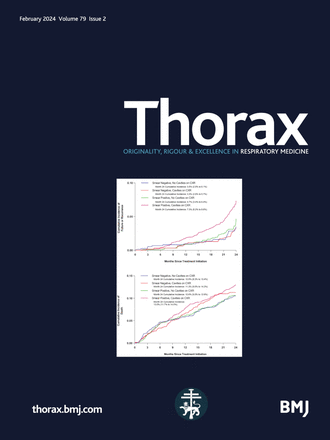优化支气管肺泡灌洗:从α-1抗胰蛋白酶缺乏症中吸取教训
IF 7.7
1区 医学
Q1 RESPIRATORY SYSTEM
引用次数: 0
摘要
背景 支气管肺泡灌洗(BAL)对于确定α-1抗胰蛋白酶缺乏症(AATD)新型疗法的疗效至关重要。这需要初步的概念验证,证明治疗用药能提高肺部的α-1抗胰蛋白酶(AAT)水平和/或抗中性粒细胞弹性蛋白酶抑制能力(ANEC)。早期阶段的研究经常会遇到 BAL 结果个体间差异较大的情况,这主要是由于返回的 BAL 液具有固有的稀释特性。为了对肺部生化终点进行可靠的比较,需要一种能将这种变异性最小化的 BAL 方案。方法 研究对象包括 21 名重度 AATD(ZZ)患者、22 名中度 AATD(MZ)患者和 23 名非 AATD(MM)患者,他们被进一步分为健康、无障碍的当前吸烟者或慢性阻塞性肺病(COPD)患者。另有 6 名 ZZ 患者正在接受α-1 静脉注射增强治疗。在报告早期生化终点、AAT 和 ANEC 时,我们比较了常用的 BAL 校正方法--白蛋白、总蛋白和通过尿素测量的上皮内衬液 (ELF) 容量。结果 与传统的成人支气管镜相比,使用儿科支气管镜(PB)进行的 BAL 可改善肺泡取样。无论肺部健康状况如何,未经校正和 ELF 校正的 BAL 均显示出较高的个体间变异性。BAL 总蛋白校正最大程度地减少了个体间变异性,使所有基因型之间的 AAT 和 ANEC 存在显著差异,与血浆 AAT 水平的关系最密切(r2=0.83),AAT 水平的肺叶间一致性最高(r2=0.76),BAL AAT 和 ANEC 之间的相关性很强(r2=0.88)。结论 通过利用 AAT 基因型之间 AAT 水平的显著一致性以及血浆和肺 AAT 水平之间的密切关系,我们展示了与血浆密切相关的可靠肺泡采样。如有合理要求,可提供相关数据。本文章由计算机程序翻译,如有差异,请以英文原文为准。
Optimising bronchoalveolar lavage: lessons from alpha-1 antitrypsin deficiency
Background Bronchoalveolar lavage (BAL) is essential in determining the efficacy of novel therapies in alpha-1 antitrypsin deficiency (AATD). These require initial proof-of-concept demonstration that treatment administration increases alpha-1 antitrypsin (AAT) levels and/or anti-neutrophil elastase inhibitory capacity (ANEC) in the lung. Early-phase studies often encounter high interindividual variability of BAL results, primarily stemming from the inherent dilution characteristics of returned BAL fluid. A BAL protocol that minimises this variability is needed for reliable comparison of biochemical endpoints in the lung. Methods The study population included 21 severe AATD (ZZ), 22 moderate AATD (MZ) and 23 non-AATD (MM) individuals, further categorised as healthy, unobstructed current smokers or patients with chronic obstructive pulmonary disease (COPD). An additional six ZZ individuals were receiving intravenous alpha-1 augmentation therapy. We compared common BAL correction methods—albumin, total protein and epithelial lining fluid (ELF) volume measured by urea—when reporting early-phase biochemical endpoints, AAT and ANEC. Results BAL performed with a paediatric bronchoscope (PB) improved alveolar sampling compared with a traditional adult bronchoscope. Both uncorrected and ELF-corrected BAL demonstrated high interindividual variability regardless of lung health status. BAL total protein correction minimised interindividual variability, producing significant differences in AAT and ANEC between all genotypes, the strongest relationship with plasma AAT levels (r2=0.83), greatest inter-lobar concordance in AAT levels (r2=0.76) and strong correlation between BAL AAT and ANEC (r2=0.88). Conclusions By capitalising on the marked consistency in AAT levels between AAT genotypes, and the close relationship between plasma and lung AAT levels, we demonstrate reliable alveolar sampling that aligns closely with plasma. Data are available upon reasonable request.
求助全文
通过发布文献求助,成功后即可免费获取论文全文。
去求助
来源期刊

Thorax
医学-呼吸系统
CiteScore
16.10
自引率
2.00%
发文量
197
审稿时长
1 months
期刊介绍:
Thorax stands as one of the premier respiratory medicine journals globally, featuring clinical and experimental research articles spanning respiratory medicine, pediatrics, immunology, pharmacology, pathology, and surgery. The journal's mission is to publish noteworthy advancements in scientific understanding that are poised to influence clinical practice significantly. This encompasses articles delving into basic and translational mechanisms applicable to clinical material, covering areas such as cell and molecular biology, genetics, epidemiology, and immunology.
 求助内容:
求助内容: 应助结果提醒方式:
应助结果提醒方式:


